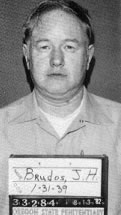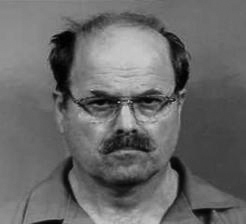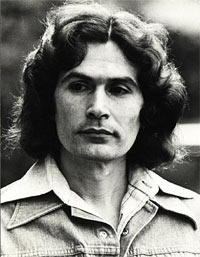Jerome Henry Brudos
The quiet Pacific Northwest in the 1960’s was home to one of the most murderous serial killers in American history. One ordinary boy, a generation earlier, who preferred to play with women’s shoes had become a native. Jerome Henry Brudos, known as the Lust Killer or the Shoe Fetish Murderer, who laid waste to a series of young lives as young women from the Portland, Oregon area, may be one of the most distastefully macabre of a notably violent and insane group of American serial killer criminals.
In 1969, local women in Portland and surrounding areas started to disappear never to return. Strangled corpses started to surface although in circumstances that meant their location was meant to be a secret. A young boy whose mother has emotionally abused him and psychologically rejected him had formed the beginnings of a vicious killer in the making. Assault grew to rape, coercion grew to abduction, cruising escalated to impersonation of a police officer. The fixated footwear fetish of Brudos had trodden into forbidden fields.
Serial killers like Jerome Brudos are truly a menace to society, both for their sophisticated attempts to mask their killing thirst and their flagrant exhibitionism of their aberrant tendencies. Jerry Brudos made no secret of the fact he had a visible gender dysfunction, which only subsided during male stereotypical experiences like (heterosexual) marriage and fatherhood. But as evidenced by earlier sexual experiences, Jerry Brudos seemed to become enabled and sexually aroused by the wearing of young women’s shoes and underwear, possibly in a trans-formative state toward a gender his mother might have found more pleasing.
Linda Slawson, 19, was a door to door encyclopedia saleswoman in January of 1968, whose chopped-off foot became a “model” for the Brudos shoe collection. Jan Whitney’s car broke down in November of 1968, and after killing the 23-year-old by strangulation Jerry Brudos violated her corpse sexually and repeated this process during the next few days in his private home workshop. Karen Sprinkler, 19, became a fatal model for Brudos in March of 1969 after being picked up in a department store parking garage. Linda Salee, 22, was coerced by Brudos from a local shopping mall.
If there is one signal mark of serial killer, it is a submerged identity trying to get out. The lack of self, the blurred border between another personality (such as a mother) and the isolation from general society and the self-identification as a “reject” or weirdo can designate many types of people into a subcategory vulnerable to criminal behavior. Jerry Brudos was a man who kept his wife under “lock and key”, had two children, made her perform household chores nude in high heels, yet viciously exercised the power of life or death over his many victims. The killings were adorned with objects like women’s underwear and shoes. In these episodes, the girl his mother had always wanted began to emerge.
The likelihood of an individual to follow the rules when they see themselves as separate and apart from society is a common thread among serial killers. Anther common denominator among serial killers is the choice by parents to ignore strong signals that important erosions in a child’s development are occurring. In the case of Jeremy Brudos, multiple alarms should have been ringing long before Brudos’ adolescence. Known as the “Lust Killer” or the “Shoe Killer”, Brudos fulfilled every dread the storied slayings of a serial killer could ever create. His psychopathy was so bizarre he would hang victims to die while watching cartoons and crank up a strangling women while idling in predatory dispassion.
Jerry Brudos was identified early as a son who had a predilection for his mother’s and then other women’s accessories shoes and clothing. Feminine behavior, playing with women’s clothing and dressing women’s shoes strongly aligns the self of a male potential killer with another life, another destiny. The committal of the serial murders is a product of the rage, anger, humiliation and suffering the individual experiences when distanced from this idea of themselves. Jerry Brudos and his killings stamped the Willamette Valley with fear, trepidation, and sadistic violence.
Maternal tirades channeled Brudos’ mixed sexual aggression and sadistic tendencies into violence. Society demands that the killer conform to outward ideals and archetypes. Like John Wayne Gacy and the Green River Killer, societal participation bred a cycle of internal pressure that was bound to break sooner or later. The disturbed tendencies of an adolescent Brudos were dismissed as psychological, not psychiatric. Underground prisons with sexual victims on tap were a theme in his fantasies. These ideas would grow to mirror reality in his workshop and garage prison of murder.
As early as age five, Brudos was instituting the wearing of women’s shoes and women’s underwear. By seventeen, his sexual tendencies veered toward the abnormal, triggered by altitudes of secrecy, fear, and aberration. Born in South Dakota in 1939, Jerry Brudos was the youngest child whose mother would have preferred a daughter. The oldest of four brothers, Larry, was the favorite. Growing into an ordinary boy, with a doughy, pale countenance, Jerry Brudos nevertheless was to electrify the Portland area with ugly murders and astonishingly sadistic sexual violence.
The following arrest of his threatening and assaulting a young girl delivered Brudos into the care of the Oregon State Psychiatric Hospital. Brudos’ nine month incarceration identified in-depth fantasies containing range and anger against his mother. Brudos was known to take women’s shoes and flee from them. The assignment of Brudos’ sexual fantasies and obsession with feminine objects was categorized into schizophrenia, yet Jerry Brudos graduated with his high school class in 1957 and went on to become an electronics technician.
His attitude toward his behavior was compulsive and psychologically satisfying but the triggers grew more serious. After high school, his behaviors continued. Joining the armed services, his dreams were of a Korean girl entering his bed and untold other secrets. His attitudes and thoughts had him cashiered out of Fort Ord. His mother Eileen ordered him to live in the shed in the back of the family house. The third-class mode of living was to have long term consequences form those who ended up his Jerry’s crosshairs. A date with a girl named Ralphene ended up pregnant and a wedding occurred.
But life was hardly linear and focused with young Jerry Brudos. He would prowl the neighborhood looking for underwear and shoes to steal, this behavior progressed to murder with follow-up segues of masturbation and more shoe wearing. For these reasons Jerry Brudos was also called the Shoe Fetish Slayer. Brudos was so inwardly focused on his sexual fantasies his marriage and children were merely secondary afterthoughts to his main program of lust killing and shoe fetish enjoyment. Stalking a woman to her apartment, her discovery of him ended up in her murder.
Serial killer experts theorize that Brudos felt more in control of women when possessing himself of their underwear and shoes, but also that he was able to participate in a feminine side of himself (as his mother had always wanted). The mutilation of the corpses exhibited both his hatred of his mother’s rejection and possibly an antipathy toward the women’s sexual characteristics he could never fully assume. Brudos took photographs and kept them as trophies of his gender based supremacy. This corresponds to the rejection of his mother towards his gender from childhood.
Brudos tried a plea of criminal insanity in court. Like many serial killers, Brudos considered himself smarter than the police. He even gave police a section of the rope he had used to hang and strangle his victims when Oregon State Police visited him for questioning. Brudo’s cruising for women locally had given police description of a “Vietnam Vet” and one woman who had narrowly avoided being killed also reported a matching description. Jerome Brudos preferred to believe himself falsely infallible to those of superior intellect and claimed an advanced IQ in later interviews.
This error was exploited at his trial as prosecutors massaged Jerry Brudos’ ego on the stand with “hypothetical” questions. His remorseless trophy taking of cut off breasts and photographs, underwear and shoes of his victims proved convenient for local police. Brudos began to confess. His sloppy attempt to evade capture were almost laughable. Brudos was arrested 250 miles from the Canadian border, as police followed with an arrest warrant. Brudos was found wearing women’s underwear, hiding under a blanket in the back seat of the car. His career of escalating torture and violence with sexual overtones and necrophilic assault of the victims dubbed him the “Lust Killer”.
Brudos was given three consecutive life sentences. Authorities probed the culpability of Jerry’s wife Ralphene who might have led police to her husband earlier in the series of killings. Psychologists have estimated that fear and denial caused Ralphene to block out the photographs of nude women she came across and the discovery of a “molded” breast, one of Brudos’ grisly murder trophies. Filing appeals while in prison, he collected women’s clothing and shoe catalogues while forming his own prison library. Convicted of three of the four murders he is believed to have perpetrated, Jerry Brudos died in prison of liver cancer in 2006.
Article by Roy Whyte . Visit his Google+ page for more.






